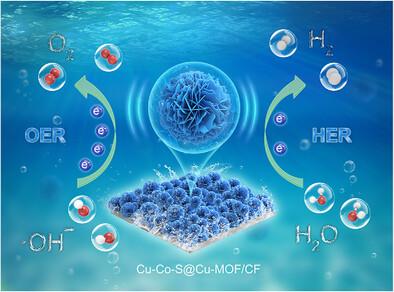泡沫铜表面的铜-硫化钴和Cu-MOF纳米花复合材料:高效双功能催化低势垒整体水分解
IF 12.1
2区 材料科学
Q1 CHEMISTRY, MULTIDISCIPLINARY
引用次数: 0
摘要
对清洁能源日益增长的需求促进了电化学水分解制氢的重要研究。然而,析氢反应(HER)和析氧反应(OER)固有的缓慢动力学要求开发高效、经济的电催化剂。在这项研究中,Cu-MOF阵列首先生长在泡沫铜上,然后通过硫化将其部分转化为硫化铜钴,从而产生非均相复合催化剂(Cu-Co-S@Cu-MOF/CF)。由此产生的分层纳米花结构有效地最大化了活性位点的暴露,同时促进电解质扩散和促进气体释放。更重要的是,铜掺杂的协同效应以及Cu-Co-S和Cu-MOF之间的强界面耦合精确地调节了钴活性位点的电子构型。这种双重优化同时降低了HER中水解离的能垒,同时加速了OER在碱性条件下的反应动力学。优化后的催化剂表现出优异的性能,在10 mA cm−2下,HER的过电位仅为72 mV, OER的过电位仅为136 mV。值得注意的是,对于整体的水分解,它只需要1.48 V来驱动相同的电流密度,同时保持超过100 h的稳定性-超过了迄今为止报道的大多数非贵金属催化剂的性能。本文章由计算机程序翻译,如有差异,请以英文原文为准。

Copper-Cobalt-Sulfide and Cu-MOF Nanoflower Composite on Copper Foam: Highly Efficient Bifunctional Catalysis for Low-Barrier Overall Water Splitting
The increasing demand for clean energy has catalyzed significant research into electrochemical water splitting for hydrogen production. However, the intrinsically slow kinetics of the hydrogen evolution reaction (HER) and oxygen evolution reaction (OER) necessitate the development of efficient and cost-effective electrocatalysts. In this study, Cu-MOF arrays are first grown on copper foam and then partially transformed them into copper-cobalt sulfide through vulcanization, yielding a heterogeneous composite catalyst (Cu-Co-S@Cu-MOF/CF). The resulting hierarchical nanoflower architecture effectively maximizes the exposure of active sites while concurrently promoting electrolyte diffusion and facilitating gas release. More importantly, the synergistic effects of copper incorporation and strong interfacial coupling between Cu-Co-S and Cu-MOF precisely modulate the electronic configuration of cobalt active sites. This dual optimization simultaneously reduces the energy barrier for water dissociation in the HER while accelerating the reaction kinetics of the OER under alkaline conditions. The optimized catalyst exhibits outstanding performance, achieving overpotentials of just 72 mV for HER and 136 mV for OER at 10 mA cm−2. Remarkably, for overall water splitting, it requires only 1.48 V to drive the same current density while maintaining stability for over 100 h—surpassing the performance of most non-noble metal catalysts reported to date.
求助全文
通过发布文献求助,成功后即可免费获取论文全文。
去求助
来源期刊

Small
工程技术-材料科学:综合
CiteScore
17.70
自引率
3.80%
发文量
1830
审稿时长
2.1 months
期刊介绍:
Small serves as an exceptional platform for both experimental and theoretical studies in fundamental and applied interdisciplinary research at the nano- and microscale. The journal offers a compelling mix of peer-reviewed Research Articles, Reviews, Perspectives, and Comments.
With a remarkable 2022 Journal Impact Factor of 13.3 (Journal Citation Reports from Clarivate Analytics, 2023), Small remains among the top multidisciplinary journals, covering a wide range of topics at the interface of materials science, chemistry, physics, engineering, medicine, and biology.
Small's readership includes biochemists, biologists, biomedical scientists, chemists, engineers, information technologists, materials scientists, physicists, and theoreticians alike.
 求助内容:
求助内容: 应助结果提醒方式:
应助结果提醒方式:


